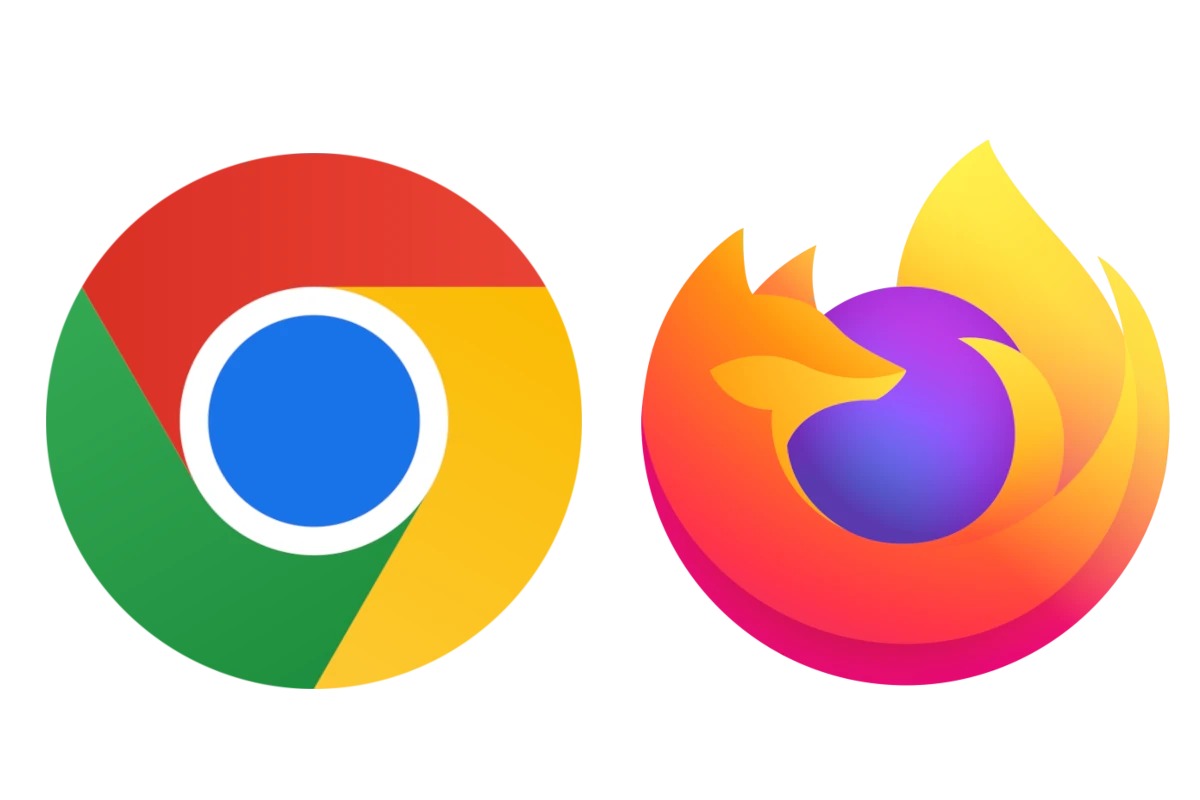When we talk about web browsers, many people think of Google Chrome and Mozilla Firefox as two of the top choices. Both browsers offer different experiences to users. Google Chrome is the most popular browser, known for its speed and connection to Google’s services. On the other hand, Firefox is praised for focusing on user privacy and effective tracking protection.

Chrome vs Firefox: A Quick Comparison
| Feature | Chrome | Firefox |
|---|---|---|
| Market Share | Dominant (over 60%) | Significant (around 10%) |
| Speed | Generally considered faster | Can be slightly slower, but improving |
| Security | Very secure, regularly updated | Very secure, focuses on privacy |
| Extensions | Vast library of extensions | Large library of extensions |
| Privacy | Good, but collects some user data | Excellent, prioritizes user privacy |
| Customization | Simpler interface, fewer options | More customizable interface |
| Platform Support | Windows, Mac, Linux, Android, iOS | Windows, Mac, Linux, Android, iOS |
| Integration | Tight integration with Google services | Less integrated with other services |
| Updates | Automatic updates | Manual or automatic updates |
Who should use Chrome?
- Users who prioritize speed and a vast extension library.
- Users who heavily rely on Google services like Gmail and Drive.
- Users who prefer a simpler interface.
Who should use Firefox?
- Users who prioritize privacy and user control over data.
- Users who appreciate frequent customization options.
- Users who don’t mind occasional updates requiring manual intervention.

Each browser has distinct advantages that can influence a user’s choice. Chrome’s extensive ecosystem and seamless integration with other Google products make it a compelling option for those invested in Google services. On the other hand, Firefox’s strong stance on user privacy and its lighter resource footprint may sway users who prioritize these aspects.
Feature-Level Comparison of Chrome and Firefox
Chrome’s Unique Strengths
While Chrome is often praised for its speed and simplicity, it also offers some unique features that enhance the browsing experience:
- Tab Groups: Chrome’s tab grouping feature allows you to organize your tabs into color-coded groups. This is incredibly helpful for managing multiple tabs and keeping your browsing workspace organized. You can easily drag and drop tabs between groups, collapse groups to save space, and even assign names to your groups for better clarity.
- Built-in Google Translate: Chrome has a built-in translation tool that can translate entire web pages with a single click. This is a convenient feature for browsing multilingual websites and understanding content in different languages. The translation is generally accurate and provides a smooth browsing experience for international users.
- Chromecast Support: Chrome seamlessly integrates with Chromecast, allowing you to easily cast web pages, videos, and other content to your TV or other Chromecast-enabled devices. This is a great feature for sharing content with others or enjoying a larger viewing experience.
Firefox’s Standout Features
Firefox has its own set of unique features that cater to specific user needs and preferences:
- Reader View: Firefox’s reader view removes distractions like ads, sidebars, and menus, providing a clean and focused reading experience. This is particularly useful for reading long articles or web pages with cluttered layouts. You can also customize the font, text size, and background color for optimal readability.
- Picture-in-Picture: Firefox’s picture-in-picture mode allows you to pop out videos into a small, floating window that stays on top of other applications. This is handy for watching videos while continuing to browse other tabs or work on other tasks.
- Pocket Integration: Firefox has built-in integration with Pocket, a popular service for saving articles and videos for later viewing. You can easily save web pages to your Pocket account with a single click and access them from any device.
Mobile Browsing: Chrome vs. Firefox
Both Chrome and Firefox offer dedicated mobile browsers for Android and iOS devices. While they share many features with their desktop counterparts, they also have some unique mobile-specific features:
- Data Saving Modes: Both browsers offer data saving modes that compress web pages and reduce data usage, which is helpful for users with limited data plans.
- Offline Reading: Both browsers allow you to save web pages for offline reading, which is useful for accessing content when you don’t have an internet connection.
- Gesture Controls: Both browsers support gesture controls for navigation, such as swiping to go back or forward, and pinching to zoom.
Mobile-Specific Features:
| Feature | Chrome | Firefox |
|---|---|---|
| Data Saving Mode | Yes | Yes |
| Offline Reading | Yes | Yes |
| Gesture Controls | Yes | Yes |
| Dark Mode | Yes | Yes |
| Tab Grouping | Yes | Limited |
User Profiles and Sync
Both Chrome and Firefox allow you to create multiple user profiles, which is helpful for sharing a device with others or separating your browsing activities for different purposes (work, personal, etc.). Each profile has its own set of bookmarks, history, settings, and extensions.
Both browsers also offer sync capabilities, allowing you to sync your browsing data across multiple devices. This includes bookmarks, history, passwords, settings, and even open tabs. Firefox places a strong emphasis on privacy with its sync feature, using end-to-end encryption to protect your data.
Security Beyond Safe Browsing
Both Chrome and Firefox utilize sandboxing technology to isolate web pages and prevent malicious code from affecting your system. This means that if a website you visit contains malicious code, it will be contained within the sandbox and won’t be able to harm your computer or access your personal data.
Both browsers also receive regular security updates to address vulnerabilities and protect against new threats. Chrome typically updates automatically in the background, while Firefox may prompt you to install updates or offer the option to update automatically.
Customization and Extensions
Both Chrome and Firefox offer a wide range of extensions that allow you to customize your browsing experience and add new functionality. Chrome has a larger extension library, but Firefox also offers a vast selection of extensions, including many that focus on privacy and security.
Both browsers also allow you to personalize the look of your browser with themes and personas. Themes change the overall appearance of the browser, while personas are simply background images for the new tab page.
Recommended Extensions:
| Category | Chrome | Firefox |
|---|---|---|
| Productivity | Evernote Web Clipper, Momentum, Grammarly | Evernote Web Clipper, Tree Style Tab, Grammarly |
| Privacy | Privacy Badger, uBlock Origin, HTTPS Everywhere | Privacy Badger, uBlock Origin, HTTPS Everywhere |
| Security | LastPass, 1Password, Malwarebytes Browser Guard | LastPass, Bitwarden, NoScript Security Suite |
Community and Support
Firefox is an open-source browser, which means its source code is publicly available and anyone can contribute to its development. This fosters a strong community of developers and users who are passionate about making Firefox the best browser it can be.
Both Chrome and Firefox offer extensive support resources, including help pages, knowledge bases, and support forums. You can also find helpful tutorials and guides online for both browsers.
By considering these additional aspects of Chrome and Firefox, you can gain a deeper understanding of their strengths and weaknesses and make an informed decision about which browser is right for you.
Key Takeaways
- Chrome holds a larger market share due to its speed and integration with Google services.
- Firefox focuses heavily on user privacy and resource efficiency.
- Users’ preferences in web browsers are shaped by factors like ecosystem integration and individual privacy concerns.
Comparative Analysis
In this section, we’ll examine the differences between Chrome and Firefox. The comparison will cover key aspects such as performance and speed, privacy and security features, and user experience and customization, highlighting each browser’s strengths in these areas.
Performance and Speed
Google Chrome is widely recognized for its superior performance, particularly in JavaScript-heavy websites. Based on the Jetstream 2 benchmark, Chrome leads with a score of 528, while Mozilla Firefox follows with a 515. The Speedometer test, which measures web app responsiveness, shows similar results, with Chrome having the edge.
System Resource Usage: Chrome is often criticized for heavy use of system resources. However, with its efficiency mode, Chrome has been attempting to address this concern.
Firefox, on the other hand, traditionally champions efficient resource management, which can be particularly beneficial for users with less powerful devices.
Privacy and Security Features
Firefox stands out in privacy and security with Enhanced Tracking Protection that automatically blocks tracking cookies, fingerprinting, and cryptominers by default. Its privacy features are robust, easily accessible, and often enabled without the need for additional add-ons.
Chrome provides security measures such as Google Safe Browsing and sand-boxing, which are effective for shielding users against malicious websites and downloads. Chrome has also embraced extensions that offer privacy solutions, like VPNs and ad blockers, although they require user installation.
Data Protection: Both browsers are committed to reducing data breach risks. Firefox displays breaches related to your email, while Chrome offers a built-in password manager to encourage strong, unique passwords.
User Experience and Customization
When it comes to customizing the user interface (UI), Firefox allows for greater flexibility. It offers a variety of themes and supports numerous extensions and add-ons to tailor the browsing experience.
Chrome’s Simple User Interface is praised for its straightforwardness. The emphasis is on minimalism and speed, often at the expense of customizability.
Features and Extensions: Both Chrome and Firefox provide a wide array of extensions. However, Chrome benefits from a larger marketplace, which translates into a more extensive selection of extensions, potentially enhancing the overall experience.
Through this analysis, it becomes evident that each browser has its particular strengths. Chrome excels in performance and speed, while Firefox is a strong contender in privacy and security. User experience varies according to personal preference, with Firefox offering extensive customization options and Chrome focusing on a streamlined, efficient approach.
Ecosystem and Integration
Choosing the right web browser depends a lot on how it works together with various services and devices. This section explores how Google Chrome and Mozilla Firefox handle the ecosystem and integration to improve the overall user experience.
Cross-Platform Availability
Google Chrome and Mozilla Firefox are accessible on several operating systems including Windows, macOS, Linux, Android, and iOS, making it easy to pick up where you left off across devices. Chrome shines with its ability to sync bookmarks, passwords, and browsing history effortlessly, especially if you’re signed into your Google account. Firefox offers similar sync capabilities and is noted for its commitment to privacy.
Browser-Specific Services and Tools
Google Chrome integrates deeply with Google services such as Gmail and its own screenshot tool, which benefits users who are invested in Google’s ecosystem. Firefox, while lacking an expansive ecosystem like Google’s, has unique features such as the Pocket for saving articles and a well-received reader mode. Both browsers provide options for password management and tackle data collection with differing approaches; Chrome favors convenience with options like auto-filling forms, while Firefox edges towards privacy.
Frequently Asked Questions
This section addresses common inquiries on the topic of Chrome versus Firefox.
What are the performance differences between Chrome and Firefox?
Chrome continues to lead in performance with a score of 528 in standard benchmarks. Firefox, while offering commendable speeds, trails slightly behind at 515. Users experience this difference in speed during activities like opening websites and running web applications.
How do user privacy features compare between Firefox and Chrome?
Firefox is acknowledged for its focus on user privacy, equipped with several built-in features to safeguard user information. Chrome also provides security measures, but it has been criticized for being less stringent compared to Firefox, due to its ties with data collection and advertising.
What are the arguments for choosing Firefox over Chrome on Android devices today?
Firefox on Android devices is favored for its privacy-centric approach and for being less demanding on the device’s memory compared to Chrome. These aspects contribute to a smoother user experience and improved device performance.
How has Firefox’s compatibility with web standards evolved in comparison to Chrome in recent years?
Firefox has made significant strides in adhering to web standards, working towards providing a consistent browsing experience across all websites. Chrome, powered by the Chromium engine, sets the benchmark for standards-compatibility, but Firefox is catching up, reducing the gap between the two.
In the context of developer support, how do Chrome and Firefox stand against each other?
Both browsers offer substantial support for developers. Chrome is known for its extensive developer tools and broad adoption. Firefox, while having a smaller user base, provides developers with innovative tools such as its integrated privacy features for testing and development purposes.
What reasons are influencing users’ switch from Chrome to alternative browsers like Firefox this year?
Users are shifting to browsers like Firefox in search of more control over their privacy and an alternative to the Chrome browser ecosystem. They are also driven by the desire for efficient memory usage and support for a browser that champions open-source development, factors where Firefox has gained ground.







